Yoga During Pregnancy

Pregnancy is one of the most special passages in a woman’s life and Yoga can play a strong supporting role in cultivating a harmonious experience for both mother and child. Yoga during pregnancy promotes optimum health of the body and mind, unifying a mother’s physical, emotional, and spiritual growth with that of the child.
Yoga is much more than stretching
 It is important to understand that Yoga is a comprehensive spiritual system. It is not simply postures or asanas, or a system of stretching, as modern classes portray it to be.
It is important to understand that Yoga is a comprehensive spiritual system. It is not simply postures or asanas, or a system of stretching, as modern classes portray it to be.
Yoga, in its most authentic form, is multifaceted and comprised of various techniques and methodologies. Each facet is an intricate and vital part of the whole system. This is what makes Yoga so unique and powerful.
Here we will discuss three yogic techniques that are notably beneficial during pregnancy. These include specific asanas, a conscious breathing technique as well as a meditation practice, all of which fall under the Yoga umbrella. There will be special mention of how the expectant mother and unborn child will prosper and thrive as a result of practicing these yogic techniques daily during the gestational period, as well as postpartum.
Asanas
Asanas are most simply defined as body postures or positions. In the Tantra Yoga system asanas are not diminished to a physical practice or a way to stretch and tone the muscles. They serve a much more mystical and crucial purpose.
When done correctly – with mental concentration and a focus on energy – asanas will bring great vitality and rejuvenating energy to mother and baby. Yoga during pregnancy should therefore definitively incorporate a few key asanas.
The expectant mother should naturally and intuitively listen to her body and respect any physical limitations that may arise. If at any point an asana feels straining or painful a woman should come out of the pose immediately. At the same time, be assured that the baby is safely guarded and protected by the abdominal wall and amniotic sac enveloping the womb.
Recommended asanas during pregnancy
 Eighty four asanas make up the classical Tantra Yoga system. While many can be safely practiced throughout pregnancy, or modified to accommodate the ever changing body of the mother during the trimesters, today we will discuss three highly regarded asanas for pregnancy. These three are quite universal and the most non-exclusive – meaning that a majority of women can perform them nimbly and harmoniously.
Eighty four asanas make up the classical Tantra Yoga system. While many can be safely practiced throughout pregnancy, or modified to accommodate the ever changing body of the mother during the trimesters, today we will discuss three highly regarded asanas for pregnancy. These three are quite universal and the most non-exclusive – meaning that a majority of women can perform them nimbly and harmoniously.
Tree pose
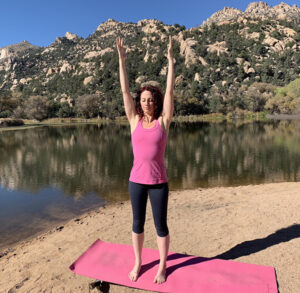
Tadasana, or tree pose, is done quite simplistically in the Tantra Yoga system. Here both feet stay firmly rooted on the ground and both arms reach up towards the sky as depicted in the photo. Hands should not be touching. Close the eyes and concentrate and focus on beneficial energies from above streaming down through the arms and accumulating in the area of the fetus (torso and abdomen). To keep this energy maintained within the physical structure and to continually build the amount of energy accumulated, apply ashwini mudra, the constant contraction of the muscles of the anus.
Hold Tadasana as long as possible. In the beginning start with 1-3 minutes and slowly build up to 5-10 minutes, nonstop. The concentration of your mind is key here. Effects will be much more powerful if you are focused on the energy flow as described above.
Ashwini mudra helps keep the anal, pelvic and vaginal muscles strong and healthy during pregnancy which will develop more tone and give more elasticity, allowing them to fully stretch for birth and then quickly return to normal post delivery.
Svastikasana
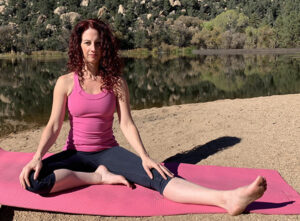
This asana helps to avoid circulation problems in the legs and swelling of the ankles that frequently develop in later pregnancy and after sitting for long periods of time. Additionally, sitting cross legged can reduce the sensation of body heaviness.
Svastikasana is a polar asana and should be done on both sides for an equal amount of time. To achieve this posture come to sitting on the floor or a yoga mat. If needed you can also use a pillow to prop yourself up and accommodate for physical limitations in the hips, knees or pelvic floor.
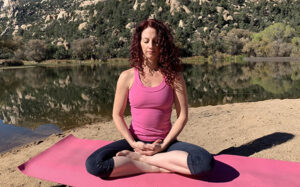
Spread the legs apart. Then, bend the right knee and place the right sole of the foot against the left inner thigh. Next, bend the left knee and place the left sole of the foot above the right, against the left inner thigh. The spine should be straight and eyes closed. Hands can be placed in the lap, palms up, with one resting on top of the other.
Focus your attention on the rising of the energy from down upwards within your being, from the pelvic floor to the crown of the head. Once the designated time is complete switch legs and perform this asana on the other side.to sitting on the floor or a yoga mat. If needed you can also use a pillow to prop yourself up and accommodate for physical limitations in the hips, knees or pelvic floor. Spread the legs apart. Then, bend the right knee and place the right sole of the foot against the left inner thigh. Next, bend the left knee and place the left sole of the foot above the right, against the left inner thigh. The spine should be straight and eyes closed. Hands can be placed in the lap, palms up, with one resting on top of the other.
Because this is a relatively easy asana to perform it can be done steadily for a long duration of time. Begin with 3-5 minutes and slowly build up to 10-15 minutes on each side.
Diamond pose

Vajrasana, or the diamond pose, is of great benefit during pregnancy because it relieves the lumbar area of the spine, making the vertebral column firm and strong. It reduces pain in the legs and greatly improves digestion. The sense of heaviness or discomfort can also be reduced greatly through performing this great asana.
For correct performance of vajrasana kneel with your knees slightly apart. The big toes should be 2-5 centimeters apart, not touching. Next, spread the heels apart as you see in the photo, so that the feet form the shape of a trough. Sit gently on the feet and place the hips and buttocks between the heels so that they are supported by the soles of the feet.
The hands should be placed on the upper thighs with the thumb pointing backwards and fingers pointing towards the groin or pelvis. Keep the spine straight and gently open and expand your chest and shoulders without excessive tension. Finally keep all unnecessary muscles relaxed. Close the eyes and focus on the energy from the pelvis and pelvic floor rising upwards along the spine to the top of the head.
If there are physical limitations and this asana cannot be performed in its fullest expression do sit on a pillow or other supportive prop.
Begin with performing this asana for 1-3 minutes continuously. As the joints become more limber and circulation improves aim to increase the performance time to 3-5 minutes. Vajrasana can be even be done for 10-15 minutes nonstop and beautiful effects with ensue.
Conscious breathing
 Focusing on the breath in a conscious and specific way charges the mother with prana and vitality for herself and the fetus. It can be an excellent way for removing toxic matter and waste products from the mother’s being and provide plentiful oxygen. Calming the nervous system and inducing an overall feeling of wellbeing are other pleasant effects conscious breathing can bring.
Focusing on the breath in a conscious and specific way charges the mother with prana and vitality for herself and the fetus. It can be an excellent way for removing toxic matter and waste products from the mother’s being and provide plentiful oxygen. Calming the nervous system and inducing an overall feeling of wellbeing are other pleasant effects conscious breathing can bring.
By training the breath throughout pregnancy a mother can develop neuro-respiratory memory and establish a rhythmic breathing pattern. The more breathing training a mother does while pregnant the better the auto-recall will be, especially in times of stress. Maintaining a calm and balanced breathing pattern is vital during childbirth and delivery.
Abdominal breathing
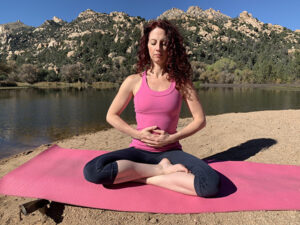
During the first three trimester the developing child is completely reliant on the mother for life force energy. According to Yoga the breath is the carrier of life force energy and therefore conscious breathing is highly recommended and beneficial. In this recommended exercise the breath will be focused on and sent to the abdominal area, so that increased oxygen and life force energy are encompassing the baby and impregnating the belly.

Even in the later stages of pregnancy, when the enlarged fetus can bring added pressure to the diaphragm of the mother, abdominal breathing can and should still be practiced regularly.
Depending on how far along a mother is the abdominal breathing exercise can be done sitting in svastikasana or lying down on the back or side. Place one hand on the belly and inhale deeply feeling the abdominal area expand or rise. Hold the breath for as long as possible, comfortably. Then exhale and feel the abdominal area deflate or relax. Do this with your eyes closed and try to envision life force energy and oxygen being sent to the baby with each inhalation.
Abdominal breathing is best performed for 10-15 minutes at a time, daily. However, as with any authentic Yoga practice the longer the duration the more powerful and accumulative the effects. Feel free to practice this technique for 20 and even 30 minutes a day.
Meditation
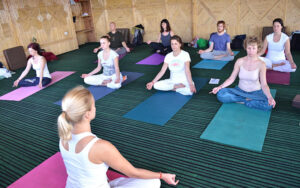 Pregnancy is an excellent time for meditation. The thoughts and emotions of the mother profoundly affect the development of the baby as well as the baby’s temperament post birth. The more the mother fills herself with elevated, spiritual thoughts, the more beneficial energies the baby will receive. ln addition, by attuning the concentration and awareness inwardly the mother has the ability to alter her mind and free herself of fears and discomfort surrounding pregnancy, childbirth and motherhood.
Pregnancy is an excellent time for meditation. The thoughts and emotions of the mother profoundly affect the development of the baby as well as the baby’s temperament post birth. The more the mother fills herself with elevated, spiritual thoughts, the more beneficial energies the baby will receive. ln addition, by attuning the concentration and awareness inwardly the mother has the ability to alter her mind and free herself of fears and discomfort surrounding pregnancy, childbirth and motherhood.
Guided meditations
We offer several free pre-recorded guided meditations which are available through our website. A guided meditation can help a practitioner surpass the conscious part of their mind where limitations lie and access the subconscious aspect which is home to pure potential, limitlessness and non-judgement.
When a guided meditation is guided by a spiritually adept teacher then valuable impressions and suggestions can be implanted deep in the mind and a person can experience a positive remodeling and upgrading of their level of consciousness. This is an important point because a mother’s consciousness merges with that of her baby and she has a considerable influence on the growing child already in the womb, even prior to birth.
Please note not all guided meditations are created equal, however. So it is imperative that a mother chooses wisely to ensure harmonious and beneficial results from her meditation efforts.
The benefits of Yoga during pregnancy
 Performing Yoga during pregnancy regularly, especially in the way that is described above, can be a gentle yet powerful way for a mother to cope with the demands that creating a new life can bring physically, emotionally, mentally and energetically. Yoga can prevent a mother from becoming depleted of her life force energy during the gestational period and will assist with a quicker recovery post birth. Of course the baby will blossom and flourish as well on many levels.
Performing Yoga during pregnancy regularly, especially in the way that is described above, can be a gentle yet powerful way for a mother to cope with the demands that creating a new life can bring physically, emotionally, mentally and energetically. Yoga can prevent a mother from becoming depleted of her life force energy during the gestational period and will assist with a quicker recovery post birth. Of course the baby will blossom and flourish as well on many levels.
Remember, regardless of the technique used, concentration of the mind is key. If you find that your mind is chaotic and it is difficult to focus then be patient yet persistent (read more here on how to tame your mind). In the meantime, whenever your mind wanders simply bring it back to the point of focus, over and over again, if necessary.
I am sending you spiritual blessings during this beautiful time and profound experience. I hope for a harmonious pregnancy for you and a gentle introduction into the joys and rewards of motherhood.